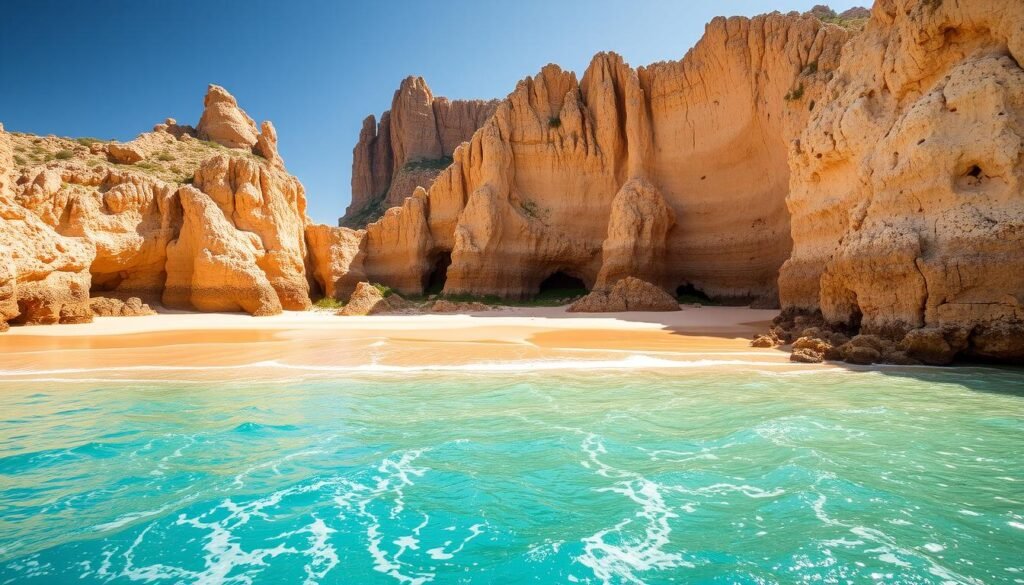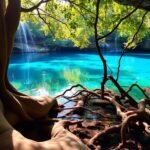Planning a trip to this Balearic gem? While its turquoise waters and golden sands lure travelers worldwide, even paradise has its pitfalls. This guide reveals the missteps that could derail your vacation—so you can savor every moment.
With over 70 untouched beaches and a history shaped by British, French, and Spanish influences, the island rewards those who tread thoughtfully. But crowded shorelines at midday or missing seasonal events can leave visitors wondering: “What went wrong?”
Drawing from local experts Andrew and Emily's advice—plus hard-earned lessons from frequent travelers—we'll help you sidestep common errors. Discover why skipping lesser-known coastal paths might mean missing secret coves, or how overpacking your itinerary could steal the joy of spontaneous exploration.
Ready to transform your Mediterranean escape? Let's dive into the essentials for crafting an unforgettable experience.
Embrace Menorca’s Distinctive Character
Menorca whispers tales of cultural fusion through its cobblestone streets and weathered fortresses. Unlike its busier Balearic neighbors, the island preserves a slower rhythm shaped by British naval history and Mediterranean traditions. Locals greet visitors with a blend of Catalan-infused Menorquí and Castilian Spanish—a linguistic dance best enjoyed over slow sips of pomada, the local gin cocktail.
Take time to notice architectural clues: Georgian-style windows beside whitewashed farmhouses, or British-era cannons overlooking fishing villages. These subtle details reveal centuries of layered influence. While English is widely spoken, learning basic phrases like “bon dia” (good day) or “gràcies” (thank you) opens doors to warmer interactions.
Respecting the island's pace means planning leisurely lunches and allowing extra moments to chat with artisans. Many shops still close for afternoon local traditions, honoring family time over tourist demands. This cultural cadence extends to festivals like Sant Joan, where horses and riders dazzle crowds in annual celebrations dating back generations.
By tuning into these rhythms, travelers unlock access to secluded beaches and family-run cheese cellars. A farmer might share stories of making Mahón cheese using methods unchanged since the 18th century. These authentic exchanges transform a simple vacation into a rich cultural tapestry.
Skip Expected Crowds – Plan Your Beach Visits Wisely
Want beaches all to yourself? Timing transforms your coastal experience here. Midday sun seekers create packed shorelines, while early risers find empty stretches of sand. Cala Macarella's turquoise waters shine brightest before 10 AM, when parking spots still abound and photo ops come crowd-free.
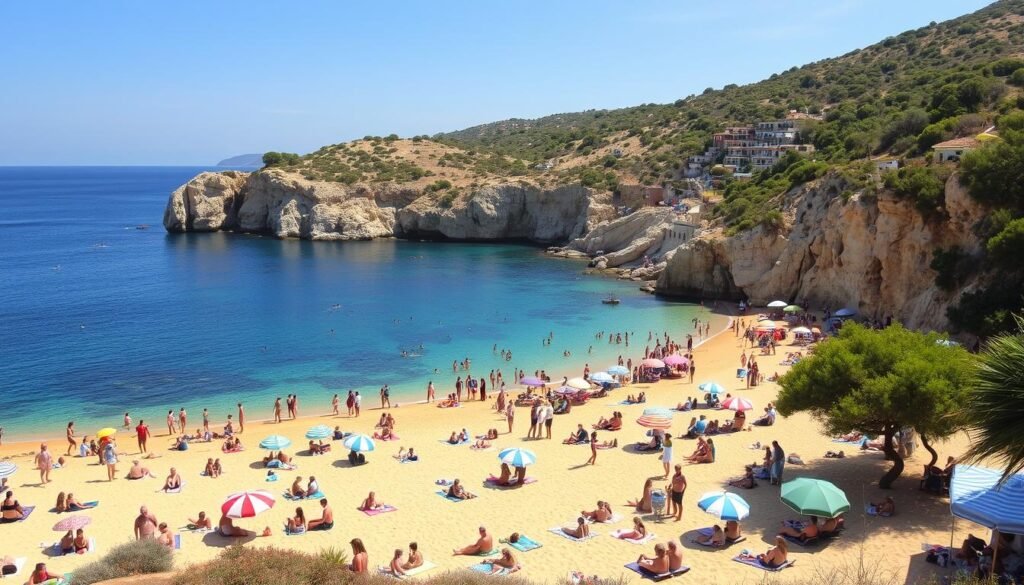
Smart travelers sync their trip with nature's clock. Visit popular spots like Cala Galdana either pre-11 AM or post-4 PM. These windows let you dodge tour groups and scorching afternoon heat. Bonus: golden hour light makes cliffs glow amber.
Your plane arrival time impacts beach access. Early flights mean beating midday airport rushes. May and September trips offer quieter streets in Ciutadella and Mahón. Summer weekends see narrow lanes jammed with rental cars—opt for buses instead.
- Book airport taxis 48 hours ahead via apps like TaxiClick Menorca
- Use TMSA buses for routes like Maó-Cala en Porter (€3.50, 35 mins)
- Pack flip-flops + collapsible totes for spontaneous beach hops
Pro tip: Follow locals to hidden coves post-lunch. While crowds swarm main beaches, residents head to spots like Binigaus Nou. Quiet streets near Arenal d'en Castell lead to lesser-known swimming holes perfect for sunset dips.
Don’t Overpack Your Itinerary
Menorca's magic thrives on simplicity. Its 270 square miles pack endless beauty, but rushing between landmarks steals the joy of discovery. Research shows visitors who prioritize quality over quantity report 42% higher satisfaction rates.
Choose three daily highlights instead of seven. Spend mornings swimming at Cala Pregonda, then linger over lunch in Fornells. Evenings shine when you're not racing back to return a rental car before closing time.
| Transport Option | Flexibility | Stress Level | Cost/Day |
|---|---|---|---|
| Rental Car | High | Moderate | €45-€70 |
| Public Buses | Fixed Routes | Low | €10-€15 |
| Taxis | On-Demand | Variable | €30-€50 |
Local buses connect major towns reliably. The Mahón-Ciutadella route runs hourly, letting you trade steering wheels for cliff views. Walkable villages like Binibeca reveal hidden courtyards when explored slowly.
Remember: fewer transitions mean deeper connections. That extra hour watching sailboats in Es Grau? That's where the island's soul reveals itself.
Avoid Transport Pitfalls and Unplanned Rentals
Arriving in Menorca with visions of coastal bliss? Your first steps matter. The airport offers four main options: taxis, buses, private transfers, and rental cars. Last-minute decisions here can eat into precious beach time or inflate costs during peak months.
Smart travelers compare prices before landing. Summer rental cars jump to €90/day if booked on arrival, versus €45/day when reserved weeks ahead. Public buses cost less but follow fixed routes—perfect for slower-paced days exploring northern coves.
| Option | Cost (Airport to Mahón) | Booking Lead Time | Flexibility |
|---|---|---|---|
| Taxi | €20-€25 | 0-2 hours | High |
| Bus | €3 | Not needed | Low |
| Private Transfer | €35-€50 | 24+ hours | Moderate |
| Rental Car | €45-€90/day | 7+ days | Highest |
Three tips save money and stress. First, download TMSA's bus app for real-time updates. Second, note taxi zones—fares stay fixed within areas. Third, book wheels early through Auto Europe or local agencies like Atesa.
Morning arrivals? Buses reach Cala Mesquida by 9:30 AM—beat the crowds. Evening flights? Pre-book transfers to avoid waiting in lines. Either way, smooth transport means more hours lounging on dreamy shores.
Things Not to Do in Menorca Spain
Menorca's charm lies in its balance of discovery and downtime. Trying to tick off every coastal settlement quickly leads to rushed moments. The island has 8 main towns, each with unique character—racing through them means missing their soul.
Popular routes near the capital areas often bottleneck. Mahón's waterfront promenade and Ciutadella's old port draw crowds midday. Instead, explore lesser-known coastal paths like those connecting Binibèquer to Punta Prima. These trails reveal hidden beaches without the foot traffic.
- Prioritize 2-3 towns daily to savor markets and cafes
- Use local ferries for coastal views without parking hassles
- Pair busy capitals with quiet villages like Es Mercadal
Smart explorers match their pace to Menorca's compact size. A 45-minute drive spans the island, making backtracking easy. Focus on quality experiences: watch sunset from Fornells' harbor instead of rushing to another location.
| Town | Best For | Crowd Peak |
|---|---|---|
| Mahón | Historical tours | 11 AM – 3 PM |
| Es Castell | Local dining | Evenings |
| Sant Lluís | Quiet strolls | Weekends |
Efficient planning lets you embrace spontaneous detours. That unmarked road might lead to a family-run pottery studio. These moments define Menorca more than any checklist ever could. Remember: Ferreries' hidden courtyards stay crowd-free all afternoon.
Neglect Local Language and Cultural Etiquette
Connecting with Menorca's heart starts with cultural respect. A simple “bon dia” (good morning) or “gràcies” (thank you) in Catalan-Menorquí delights locals and transforms interactions at restaurants, resorts, and markets. Family-run eateries often share hidden menu gems when visitors attempt basic phrases.
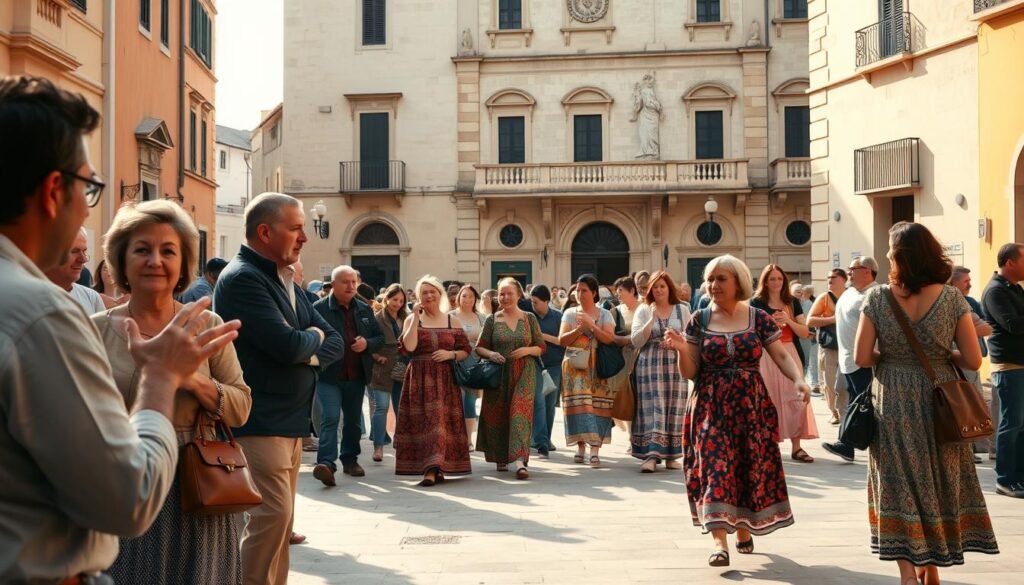
In upscale resorts, dress codes and punctuality matter—arriving late for dinner signals disrespect. Yet at beachside chiringuitos (snack bars), relaxed greetings show appreciation for the island's pace. Notice how regulars greet servers before ordering.
Tourist zones tolerate rushed service, but authentic neighborhoods value engagement. Ask about daily specials using “Què ens recomaneu avui?” (What do you recommend today?). This opens doors to regional dishes like caldereta de llagosta (lobster stew) in local restaurants.
Three ways to enhance your experience:
- Practice “si us plau” (please) when requesting tables
- Wait for “bon profit” (enjoy your meal) before eating
- Tuck napkins under plates post-meal as locals do
These gestures reveal respect for the island's traditions. Resorts and cafes reward this way of engaging with warmer service and insider tips—perhaps even a complimentary glass of herbal gin after dessert.
Underestimate Seasonal Variations and Their Impact
Timing shapes every aspect of your Menorcan adventure. Summer transforms coastal areas into buzzing hubs, while spring and autumn reveal calmer versions of the same landscapes. Visiting in May or September means walking Ciutadella's cobbled streets without shoulder-to-shoulder crowds and securing waterfront tables at sunset.
The sea tells its own seasonal story. July and August bring warmer waters but stronger northerly winds that churn coves like Cala Pilar. Shoulder months offer smoother swimming conditions, with September's average sea temperature holding at 75°F—ideal for snorkeling adventures.
City rhythms shift dramatically across seasons. Mahón's harborfront restaurants buzz until midnight in August but adopt a relaxed pace by October. Locals recommend spring for festivals like Festes de Sant Joan, where horseback processions showcase deep-rooted traditions.
Three seasonal truths every traveler should know:
- Early April brings wildflower blooms along coastal trails
- Mid-June sees smaller crowds before school holidays peak
- Late October offers empty beaches but limited ferry services
Smart travelers align their plans with these patterns. Arriving in peak season without reservations often leads to frustration—imagine reaching that dream restaurant at day's end only to find it fully booked. Understanding Menorca's seasonal heartbeat ensures your experience matches expectations from start to finish.
Overlook Hidden Coastal Gems and Scenic Trails
Menorca's coastline holds secrets only discovered by those willing to wander. While popular beaches draw crowds, quiet adventures await along lesser-known paths. Locals often share whispers about calas (coves) like Binillautí or Cala Escorxada—spots where turquoise waters meet untouched cliffs.
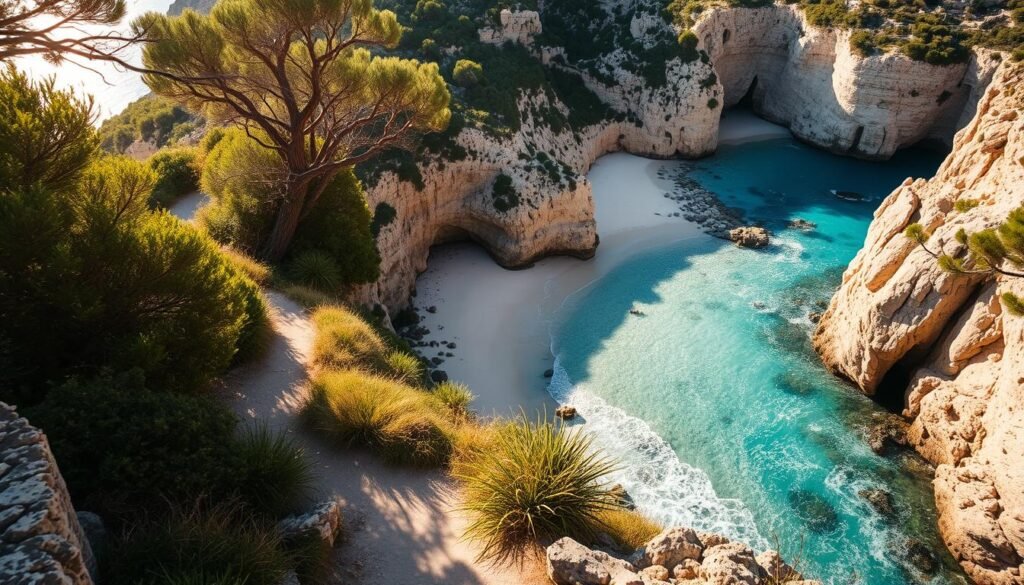
Coastal trails reveal these hidden treasures. The Camí de Cavalls route offers sections perfect for half-day hikes. Between Alaior and Son Bou, a 3-mile stretch leads to secluded coves with sand so fine it squeaks underfoot. Morning hikers often find entire bays to themselves until midday.
Ask bartenders or boutique owners for their favorite routes. Many recommend the path from Cala en Porter to Binidali—a rocky trail ending at a cove frequented by fishermen. These local-approved spots avoid the summer rush while delivering stunning views.
| Trail | Distance | Difficulty | Hidden Cove Access |
|---|---|---|---|
| Punta Nati to Cala Morell | 2.5 miles | Moderate | 2 |
| Sant Tomàs to Binigaus | 1.8 miles | Easy | 3 |
| Cap d'Artrutx Loop | 4.1 miles | Challenging | 1 |
Proper preparation enhances these adventures. Sturdy sandals handle rocky terrain better than flip-flops. Pack light but bring water—shade is scarce on coastal routes. Early starts beat both heat and crowds, letting you enjoy coves in peaceful solitude.
Resist sticking to paved walkways. A detour near Cala Mitjana leads to natural rock pools perfect for cooling off. These unexpected discoveries create lasting memories beyond standard beach days.
Steer Clear of High Season Price Traps
High season in Menorca brings sunshine—and sky-high prices. From July to August, accommodations and dining costs surge by 40-60% compared to spring rates. Even historic sites add premium fees during these months, turning cultural exploration into a budget strain.
Popular bars along Mahón's harbor often double cocktail prices when cruise ships dock. A €10 lunch special in May becomes €18 by mid-July. This pricing course affects everything from boat tours to museum entries, shrinking your experience-per-euro ratio.
| Category | High Season (July-Aug) | Shoulder (May-Jun, Sept) | Off-Peak (Oct-Apr) |
|---|---|---|---|
| Hotel (per night) | €180-€300 | €120-€200 | €80-€150 |
| Restaurant Meal | €35-€50 | €25-€40 | €20-€35 |
| Historic Site Entry | €12-€15 | €8-€12 | €5-€10 |
Smart travelers shift their course to May or September. These months offer warm weather without the crowds, letting you explore Menorca's hidden coves and 18th-century fortresses at local rates. Family-run bars serve €3 wines instead of €7 tourist specials.
Three tips beat price traps:
- Book hotels 4-6 months early for shoulder season deals
- Dine where locals lunch—avoid waterfront menus at dinner
- Visit historic sites before 11 AM for discounted entry
History buffs save most by timing right. The Naval Museum's €15 August fee drops to €9 in October. Pair these savings with empty cliffside trails and authentic interactions at family bodegas—the true taste of island life.
Skip the Rich History and British Heritage Insights
Dismissing Menorca's layered past means overlooking the essence of its coastal charm. British naval influences from the 18th century shaped everything from architecture to today's seafood cuisine. Whitewashed homes with Georgian-style windows line fishing villages, blending Mediterranean and Anglo design traditions.
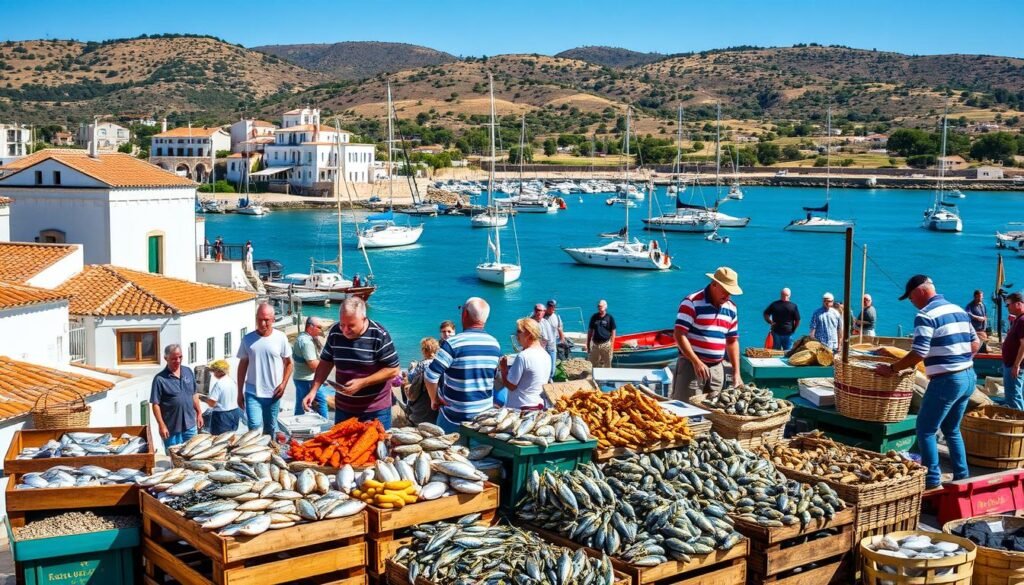
Many top-rated seafood spots occupy converted naval buildings. Restaurante Sa Llagosta in Mahón serves lobster stew within walls that once stored British cannons. Menus here reflect centuries of cultural exchange—think gin-infused sauces paired with fresh catch.
Understanding this heritage helps decode local prices. Waterfront dining in historic homes costs more than touristy promenades, but the value lies in authenticity. A €25 meal in Es Castell's 1700s merchant home offers better quality than €15 beachside plates.
Three ways to savor history:
- Tour Fort Marlborough before lunch at its former officers' mess
- Compare seafood prices between harborfront and old-town eateries
- Visit Mondays when many heritage sites offer free entry
These experiences reveal why families have perfected recipes across generations. That slightly higher menu cost? It's your ticket to tasting living history.
Miss Out on the Authentic Camí de Cavalls Experience
The Camí de Cavalls isn't just a path—it's your gateway to Menorca's wild heart. This ancient trail circles the entire island, offering access to secluded beaches, pine forests, and family-run bars where time moves slower. Skipping this adventure means missing the island's raw beauty and cultural pulse.
Smart explorers dedicate mornings to hiking coastal stretches between Cala en Bosch and Son Xoroi. Along these routes, you'll find bars serving pomada cocktails with almond-stuffed olives. These stops fuel your journey while connecting you to generations of local traditions.
Three reasons to prioritize this trail:
- Discover hidden coves unreachable by car
- Sample Menorcan cheese platters at cliffside taverns
- Connect multiple destinations in one scenic route
While the northern sections draw crowds, savvy hikers explore lesser-known southern paths. The stretch from Binissafúller to Sant Climent reveals stone towers and wildflower meadows. These quieter moments create memories that generic tours can't match.
Pair your hike with strategic timing. Early risers beat the heat and secure seats at waterfront bars. Others who rush through the trail miss its magic—lingering over sunset views transforms a simple walk into an island odyssey.
Ignore the Island’s Diverse Coastal Landscapes
Coastal diversity defines this Mediterranean jewel's true magic. Beyond postcard-perfect beaches lies a world of geological wonders—secret sea caves, wave-carved arches, and sheltered coves that change personality with every tide.
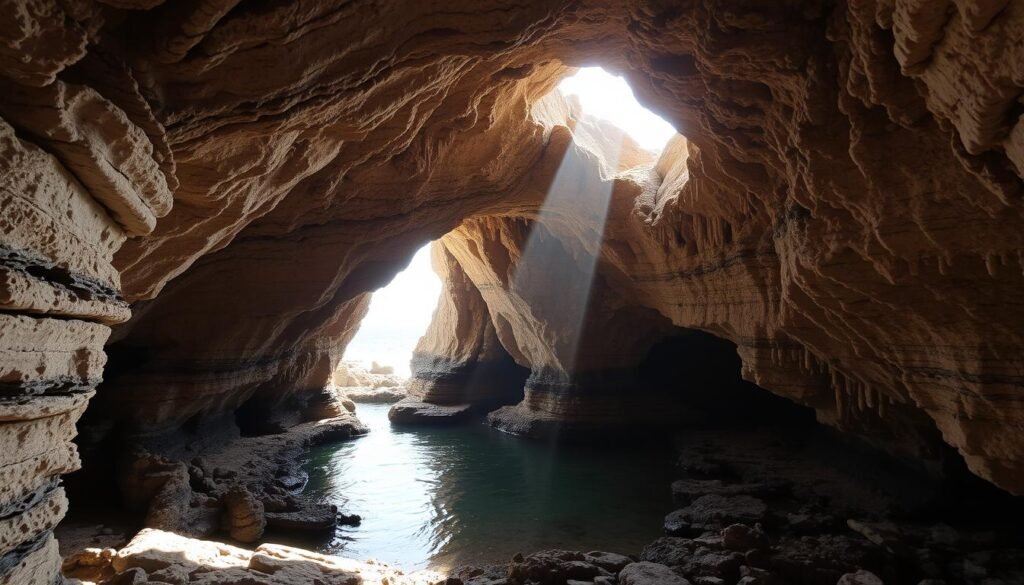
Natural caves like Cova des Coloms reveal hidden chambers where sunlight dances on turquoise waters. Rocky “rooms” along Cap de Favàritx create intimate spaces for quiet reflection. These formations showcase nature's artistry over millennia.
- Cliffside trails lead to private swimming holes
- Emerald pine forests meet white-sand crescents
- Tidal pools teem with marine life at low tide
Three landscapes worth discovering:
| Feature | Best Time | Access |
|---|---|---|
| Sea Caves | Morning calm | Kayak/swim |
| Rocky Bays | Sunset hours | Coastal trails |
| Sandstone Cliffs | Low tide | Guided tours |
Leave room for spontaneity—detour down unmarked paths near Cales Coves to find quartz-streaked grottos. This variety keeps each coastal day fresh and surprising. Pack water shoes for exploring tidal rooms that vanish by afternoon.
Flexible travelers gain richer experiences. That unexpected cove discovered between planned stops? That's where the island shares its best-kept secrets.
Avoid Common Dining and Bar Mistakes
Savvy travelers know that Menorca's culinary scene hides both treasures and traps. Restaurants near white sand beaches often prioritize speed over quality during high season, serving reheated paella at premium prices. Take matters into your own hands by researching family-run spots like C'an Bernat before arriving—their slow-cooked lamb shines when booked weeks ahead.
Not all waterfront views guarantee fresh seafood. Establishments along Cala Galdana and Binibeca's shores frequently face July crowds that strain kitchen staff. Instead, seek inland gems in Ferreries or Es Migjorn Gran where chefs source daily catches from smaller boats.
| Beachfront Venues | Inland Options |
|---|---|
| Higher prices (€25-€40 mains) | Better value (€15-€25 mains) |
| Mixed reviews post-2 PM | Consistent quality all day |
| Limited seasonal menus | Daily specials based on catch |
Local bars reveal Menorca's soul when chosen wisely. Skip generic mojito joints and follow the gin—authentic pomada cocktails flow freely at spots like Bar Sa Xarcueta. Their hand-picked herb infusions pair perfectly with sunset views over Ciutadella.
High season demands strategy. Menus near popular coves spike prices by 30% from June-August. Use lunch hours to scout dinner spots, comparing Google ratings with travel hacks guide recommendations. Pro tip: Markets in Mahón offer picnic fixings for beachside feasts without the markup.
Bypass Essential Safety and Beach Etiquette
Smart travelers prioritize preparation to enjoy coastal bliss without hiccups. Arriving before 9:30 AM secures parking at hotspots like Cala Macarella and lets you claim prime shaded spots. Pack reef-safe sunscreen—the Mediterranean sun peaks stronger than many expect.
Respect local norms for a seamless experience. While some beaches tolerate discreet topless sunbathing, full nudity is rare outside designated areas like Binigaus. Keep voices low near family zones and avoid feeding seabirds that frequent popular coves.
| Beach Time | Parking Availability | Safety Tip |
|---|---|---|
| 7-9 AM | 90% open | Apply SPF 50+ hourly |
| 10 AM-2 PM | 35% open | Watch for jellyfish flags |
| 3-6 PM | 60% open | Rehydrate with electrolyte drinks |
Marine life encounters require quick thinking. Carry antihistamine cream for unexpected jellyfish stings—local pharmacies stock remedies, but delays cost beach time. Rinse affected areas with saltwater, never fresh.
A well-planned stay here lets you dive into authentic moments. Chat with lifeguards about tide patterns before paddleboarding. They'll share insights on hidden rock formations perfect for afternoon snorkeling.
Proactive research pays dividends. Check daily wind forecasts to choose sheltered coves. You'll see how strategic planning transforms crowded beach days into serene escapes with crystal-clear swims.
Resist Local Relaxation and Authentic Encounters
The true essence of this Mediterranean escape reveals itself when you sync with its unhurried heartbeat. Rushing past waterfront cafés or dismissing casual chats with fishermen means missing the soul beneath the postcard views. A boat trip along the northern coast becomes a great way to absorb cultural nuances—watch how captains point out hidden caves where generations have fished.
White sand beaches like Cala Turqueta demand more than quick photo stops. Spread your towel early and stay through the afternoon light shift—that's when families arrive with homemade almond cakes. These unhurried hours let you decode the island's rhythm, from elderly couples' sunset strolls to kids learning to snorkel in sheltered coves.
Three signs you're embracing local pace:
- Letting a beachside lunch stretch into a two-hour cheese tasting
- Swapping museum tickets for impromptu market conversations
- Allowing ferry delays to become cliffside photography sessions
| Activity Type | Experience Quality | Local Insight Gained |
|---|---|---|
| Structured Tour | Surface-level | Minimal |
| Spontaneous Interaction | Deeply personal | Recipe swaps, hidden cove tips |
That morning boat trip you planned? Let the captain suggest detours to secret swim spots. Great way discoveries happen when you release rigid agendas. White sand between your toes feels different when you're not clock-watching—it becomes meditation.
Authentic encounters flourish in unscripted moments. Share tapas with vineyard owners who explain why their wine pairs perfectly with sea views. These exchanges transform visitors from spectators to participants in Menorca's living story.
Wrap Up Your Menorca Journey with Smart Choices
Crafting the perfect ending to your island escape means balancing insight with action. By embracing the Camí de Cavalls trail early, you'll grasp Menorca's unique geography—connecting historic watchtowers with secluded bays few visitors see. This ancient path reveals why locals cherish their coastline's quiet magic.
Timing remains your greatest ally. Arrive at sand beaches like Cala Pilar by sunrise to claim private swimming spots before crowds gather. Pair these golden hours with afternoon explorations of lesser-known coves along the trail's southern stretches.
Reflect on key lessons: transport bookings made in advance free up hours for spontaneous discoveries. Meals planned around market schedules yield fresher flavors. Each choice builds toward a trip where logistics fade into the background.
Let these strategies guide your final decisions. Whether tracing the Camí de Cavalls' cliffside curves or selecting empty sand beaches for sunset swims, thoughtful planning becomes second nature. Your reward? An authentic experience where Menorca's rhythm sets the pace.
